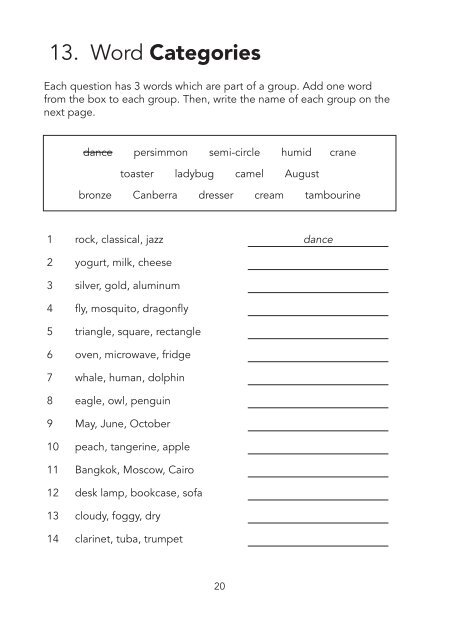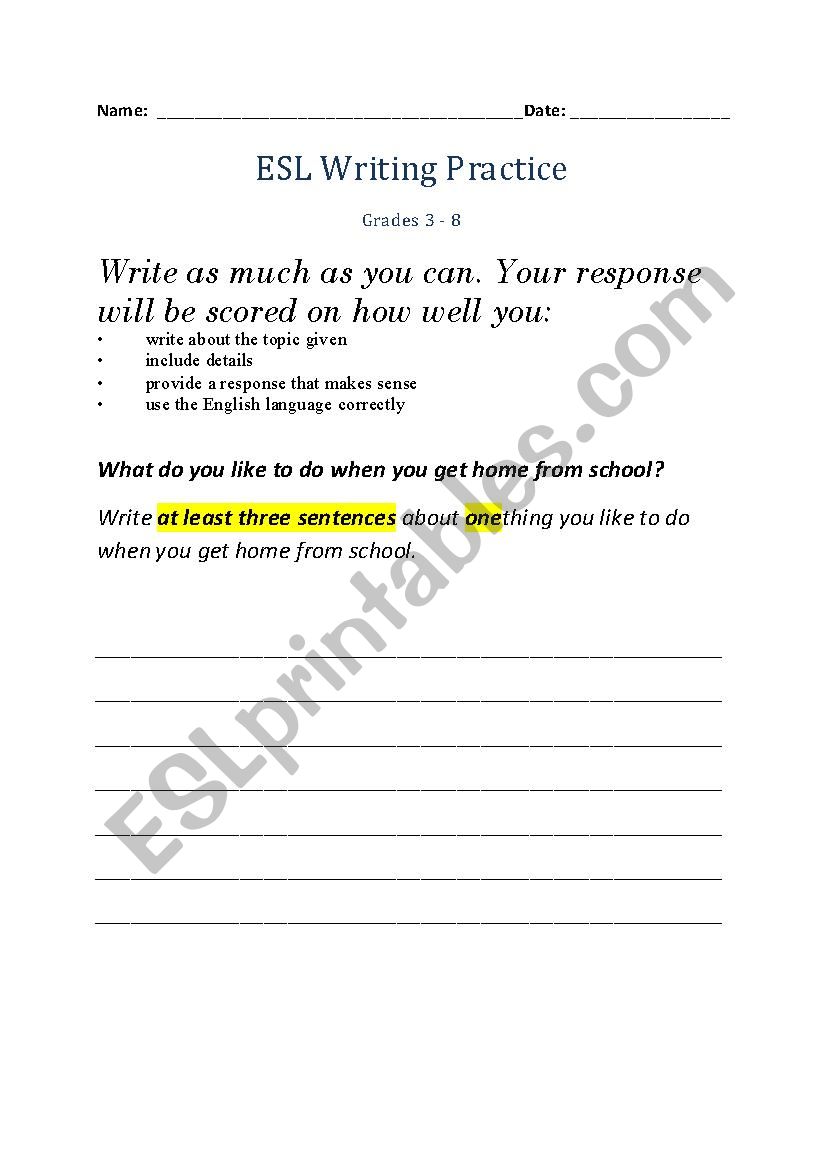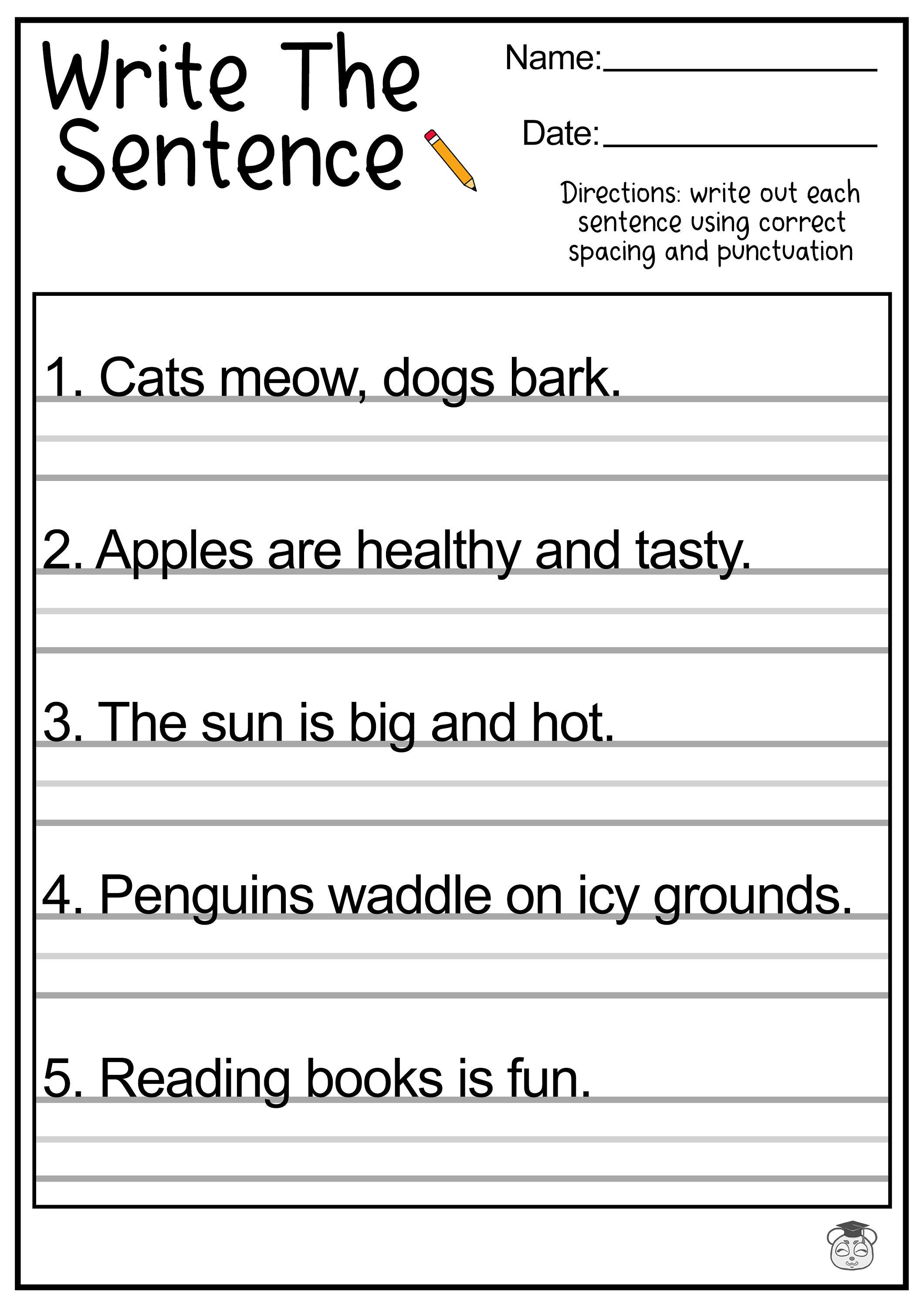
Unlocking English Fluency: Effective Writing Exercises for ESL Worksheets
In the intricate journey of mastering a new language, speaking and listening often take center stage. However, for true proficiency and a deep understanding of English, the often-overlooked skill of writing is paramount. Writing not only solidifies grammatical structures and expands vocabulary but also hones critical thinking and organizational skills. For English as a Second Language (ESL) learners, especially those navigating the complexities of academic or professional communication, well-designed writing exercises for ESL worksheets are indispensable tools.
This article delves into the significance of writing for ESL learners, explores the principles behind effective writing exercise design, and provides a comprehensive range of practical writing exercises for ESL worksheets tailored to various proficiency levels. We will also touch upon the crucial role of feedback and revision in the writing process.
The Indispensable Role of Writing for ESL Learners

Writing is far more than merely putting words on paper; it is a complex cognitive process that integrates multiple language skills. For ESL learners, engaging in regular writing practice offers a multitude of benefits:

- Grammar and Syntax Reinforcement: Writing compels learners to consciously apply grammatical rules, sentence structures, and punctuation. Unlike spoken language where errors can be quickly corrected or overlooked, writing provides a tangible record that allows for reflection and self-correction.
- Vocabulary Acquisition and Usage: Writing tasks often necessitate the retrieval and appropriate application of new vocabulary. Learners move beyond passive recognition to active production, cementing words and phrases in their long-term memory.
- Cohesion and Coherence: Effective writing requires ideas to be logically organized and connected. Learners practice using transition words, cohesive devices, and paragraphing to create clear and understandable texts.
- Critical Thinking and Problem Solving: Many writing exercises, especially at higher levels, demand analysis, synthesis, evaluation, and argumentation. This process stimulates critical thinking skills, allowing learners to articulate complex ideas.
- Preparation for Academic and Professional Settings: Academic essays, reports, emails, and presentations are integral to higher education and professional life. Early and consistent practice through structured writing exercises prepares ESL learners for these real-world demands.
- Confidence Building: As learners see their ability to produce coherent and grammatically correct English texts improve, their confidence in their overall language proficiency grows, which in turn positively impacts their speaking and listening skills.




Principles of Designing Effective Writing Exercises for ESL Worksheets
The efficacy of writing exercises for ESL worksheets hinges on their thoughtful design. Merely assigning a topic is insufficient; exercises must be structured to guide learners, address specific linguistic challenges, and foster a positive learning environment. Here are key principles:

- Scaffolding: Exercises should progress from simpler to more complex tasks, providing necessary support at each stage. This might involve starting with guided writing, moving to semi-guided, and eventually to free writing.
- Clear Objectives: Each exercise should have a specific learning objective, whether it’s practicing a particular tense, using connectors, developing a thesis statement, or writing a persuasive argument. Learners should understand what skill they are meant to acquire or improve.
- Relevance and Authenticity: Exercises should connect to learners’ real-world needs and interests. Authentic tasks, such as writing emails, social media posts, or short reviews, increase engagement and demonstrate the practical utility of writing.
- Variety: A diverse range of exercise types keeps learners motivated and addresses different learning styles. Mixing creative writing with functional writing, short responses with longer compositions, prevents monotony.
- Focus on Process, Not Just Product: Emphasize the stages of writing – brainstorming, outlining, drafting, revising, editing. Worksheets can include sections for pre-writing activities and revision checklists.
- Manageable Length and Scope: Tasks should be appropriate for the learners’ proficiency level and available time. Overwhelming tasks can lead to frustration and disengagement.
- Opportunity for Feedback and Revision: Worksheets should ideally incorporate space or prompts for self-correction, peer feedback, or instructor comments, making revision an integral part of the learning cycle.


Practical Writing Exercises for ESL Worksheets Across Proficiency Levels
These diverse writing exercises for ESL worksheets cater to different proficiency levels, ensuring that learners are challenged appropriately while building foundational skills.
Beginner Level (A1-A2)
At this stage, the focus is on building basic sentence structures, using simple vocabulary, and expressing personal information.
- Sentence Completion:
- Exercise: Provide incomplete sentences related to a theme (e.g., daily routine, family, hobbies) and have learners complete them.
- Example: "My name is . I am from . I like to _____."
- Benefit: Reinforces basic sentence patterns and vocabulary.
- Picture Description:
- Exercise: Show a simple picture (e.g., a room, a street scene, a person doing an activity) and ask learners to write 3-5 sentences describing what they see.
- Example: "There is a cat on the . The cat is ."
- Benefit: Practices observation skills, uses basic adjectives and prepositions, and forms simple declarative sentences.
- Basic Journaling/Daily Routine:
- Exercise: Provide prompts like "What did you do yesterday?" or "Describe your typical morning." Learners write short, simple sentences.
- Example: "Yesterday, I woke up at 7 AM. I ate breakfast. I went to school."
- Benefit: Encourages personal expression, practices past tense or present simple, and builds narrative skills.
- Fill-in-the-Blanks Stories:
- Exercise: Provide a very short story with key verbs, nouns, or adjectives removed. Learners fill in the blanks.
- Example: "The little [adjective] dog ran to the [noun]. It wanted to [verb] the ball."
- Benefit: Focuses on word categories and basic sentence construction within a context.
- Simple Information Forms:
- Exercise: Design a mock form (e.g., library card application, event registration) where learners fill in their personal details.
- Benefit: Practices writing essential personal information, names, addresses, and numbers accurately.
Intermediate Level (B1-B2)
Learners at this level can form more complex sentences, express opinions, and write short paragraphs. The exercises move towards developing cohesive paragraphs and simple essays.
- Paragraph Writing (Topic Sentences & Supporting Details):
- Exercise: Provide a topic sentence (e.g., "Studying English has many benefits.") and ask learners to write 3-4 supporting sentences. Alternatively, give supporting details and ask for a topic sentence.
- Benefit: Teaches paragraph structure and the concept of main ideas supported by evidence.
- Summary Writing (Short Texts):
- Exercise: Give a short, simple article or passage (50-100 words) and ask learners to summarize it in 2-3 sentences.
- Benefit: Develops reading comprehension and the ability to extract main ideas concisely.
- Opinion Paragraphs (Agree/Disagree):
- Exercise: Present a simple statement (e.g., "Social media is good for society.") and ask learners to write a paragraph expressing agreement or disagreement, providing reasons.
- Benefit: Practices expressing opinions, using transition words (e.g., "firstly," "however"), and supporting arguments.
- Letter Writing (Informal/Formal Basics):
- Exercise: Provide scenarios for informal letters (e.g., writing to a friend about a holiday) or simple formal letters (e.g., requesting information).
- Benefit: Introduces different registers, appropriate greetings/closings, and common letter structures.
- Sequencing Events/Instructions:
- Exercise: Provide jumbled steps for a simple process (e.g., making coffee, getting ready for school) and ask learners to write them in the correct order using sequence words (first, next, then, finally).
- Benefit: Improves logical organization and the use of temporal connectors.
- Descriptive Essays (Short):
- Exercise: Ask learners to describe a place, person, or object using sensory details. Provide a graphic organizer for brainstorming.
- Benefit: Enhances vocabulary related to description and encourages the use of vivid imagery.
Advanced Level (C1-C2)
At this stage, learners are expected to produce well-structured, coherent, and sophisticated texts. Exercises focus on argumentation, analysis, research, and nuanced expression.
- Argumentative/Expository Essays (Full Length):
- Exercise: Present complex prompts (e.g., "Discuss the impact of AI on education," "Analyze the pros and cons of globalization"). Learners write multi-paragraph essays with thesis statements, body paragraphs, and conclusions.
- Benefit: Develops advanced critical thinking, research skills, logical argumentation, and essay structure.
- Research Summaries/Reports:
- Exercise: Provide a short academic article or research paper and ask learners to write a summary, abstract, or a brief report on its findings.
- Benefit: Practices academic writing conventions, paraphrasing, summarizing complex information, and citing sources (even if informally).
- Creative Writing (Short Stories, Poetry, Screenplays):
- Exercise: Provide a specific prompt (e.g., "Write a short story starting with ‘The old key opened a door to another dimension.’"), a character, or a setting.
- Benefit: Fosters imagination, expands vocabulary, allows for experimentation with style and voice, and develops narrative complexity.
- Critiques and Reviews:
- Exercise: Ask learners to write a review of a book, movie, restaurant, or a critique of an article, justifying their opinions with evidence.
- Benefit: Encourages analytical thinking, persuasive writing, and the use of evaluative language.
- Academic Essay Types (Compare/Contrast, Cause/Effect):
- Exercise: Provide specific topics that require these rhetorical modes (e.g., "Compare and contrast living in a big city vs. a small town," "Discuss the causes and effects of climate change").
- Benefit: Master specific essay structures and the vocabulary associated with these patterns.
- Business Writing (Emails, Memos, Reports):
- Exercise: Present professional scenarios requiring formal communication (e.g., writing a complaint email, a proposal memo, a progress report).
- Benefit: Teaches professional tone, formatting, and common phrases used in business contexts.
The Crucial Role of Feedback and Revision
The effectiveness of any writing exercises for ESL worksheets is significantly amplified by a robust feedback and revision cycle. Simply completing an exercise is only half the battle; the real learning occurs when learners reflect on their work and make improvements.
- Constructive Feedback: Feedback should be specific, actionable, and encouraging. Focus on a few key areas for improvement rather than overwhelming the learner with every single error. Highlight strengths as well as weaknesses.
- Peer Review: Encouraging learners to review each other’s work helps them develop a critical eye, identify common errors, and learn from their peers’ strengths. Worksheets can include peer review checklists.
- Self-Correction: Provide editing checklists focusing on common errors (e.g., subject-verb agreement, tense consistency, punctuation). This empowers learners to become independent editors of their own work.
- Iterative Process: Emphasize that writing is rarely perfect in the first draft. Encourage multiple drafts and view revision as an opportunity for improvement, not a sign of failure.
Conclusion
Writing is an indispensable pillar of language proficiency, particularly for ESL learners striving for fluency and accuracy. By systematically integrating a variety of writing exercises for ESL worksheets, educators can provide learners with the structured practice necessary to develop strong grammatical foundations, expand vocabulary, refine critical thinking, and communicate effectively in diverse contexts.
From simple sentence construction at the beginner level to complex argumentative essays at the advanced stage, well-designed writing exercises empower learners to navigate the intricacies of English with confidence and precision. Coupled with thoughtful feedback and a focus on the iterative nature of writing, these exercises transform the daunting task of writing into a rewarding journey towards true linguistic mastery. Investing in comprehensive and engaging writing practice is not just about teaching a skill; it’s about unlocking a learner’s full potential in the English language.
